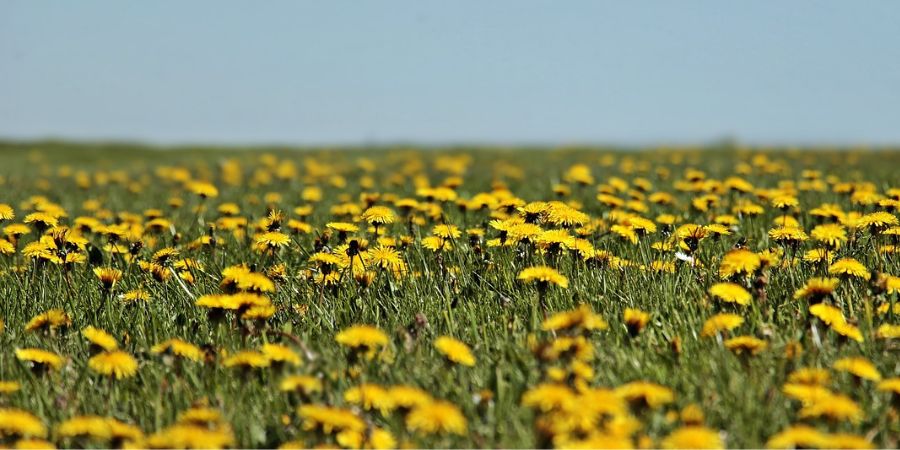Weeding is an essential part of garden maintenance, but it can be a daunting task, especially when it comes to distinguishing between weeds and desirable plants. There are several common weeds that can invade your garden, competing with your plants for nutrients, water, and light. By identifying these weeds early, you can remove them more effectively and prevent them from taking over your garden. Here’s a guide to help you identify some of the most common weeds you’ll come across.
Note: The perception of weeds can indeed vary widely among gardeners and even among different cultures and contexts. While many gardeners view weeds as unwanted plants that compete with cultivated crops or ornamental plants for resources, others may see them differently for several reasons including aesthetics, medicinal and edible purposes, and more.
Dandelion
Identification:
- Leaves: Dandelions have deeply toothed, spoon-shaped leaves that grow in a rosette pattern close to the ground.
- Flowers: Bright yellow flowers that turn into white, fluffy seed heads.
- Roots: Long, thick taproots.
Control: Dandelions are easier to pull when they are young. Ensure you remove the entire taproot to prevent regrowth. Mulching can help prevent their seeds from germinating.
Fun Fact: All parts of the dandelion are edible and used in a variety of ways.
Creeping Charlie
Identification:
- Leaves: Round or kidney-shaped leaves with scalloped edges and a minty aroma when crushed.
- Flowers: Small, purplish-blue, funnel-shaped flowers.
- Growth Habit: Creeps along the ground, forming dense mats.
Control: It is very easy to hand-pull or use a hoe to remove creeping Charlie. Making sure to get all the runners and roots, because that is how it spreads. Regular mowing can help manage it, but a dense, healthy lawn is the best defense.
Quackgrass
Identification:
- Leaves: Long, narrow, rough-textured leaves with a prominent mid-vein.
- Growth Habit: Spreads via rhizomes (underground stems) that can quickly take over a garden.
- Flowers: Seed heads resemble wheat, with long, pointed awns.
Control: Dig up the plants, making sure to remove all rhizomes. Regular cultivation can help control its spread, but persistent monitoring is required.
Common Ragweed
Identification:
- Leaves: Deeply lobed, fern-like leaves that are hairy and rough to the touch.
- Flowers: Small, greenish flowers that produce a significant amount of pollen.
- Growth Habit: Upright growth, reaching up to several feet tall.
Control: Pull ragweed before it flowers to prevent it from seeding. Regular mowing and maintaining a healthy, thick garden can reduce its presence.
Note: Ragweed is a common allergen that affects many people, particularly during late summer and early fall when its pollen is released into the air.
Visit Applewood Nursery & Landscape Supply, Your One-Stop Landscape Shop!
Lamb’s Quarters
Identification:
- Leaves: Diamond- or lance-shaped leaves with a powdery coating on the underside.
- Flowers: Small, green, inconspicuous flowers in clusters at the tips of stems.
- Growth Habit: Can grow up to several feet tall, often found in disturbed soil.
Control: Hand-pulling is effective when the plants are young. Cultivating the soil can help disrupt the growth of seedlings.
Fun Fact: Some gardeners intentionally cultivate Lamb’s Quarters for its edible leaves and beneficial qualities, especially in permaculture and sustainable gardening practices.
Purslane
Identification:
- Leaves: Succulent, paddle-shaped leaves that are smooth and shiny.
- Stems: Red, prostrate stems that radiate from a central point.
- Flowers: Small, yellow flowers that open in the morning.
Control: Remove by hand, ensuring to pull out the entire plant and root system. Mulching can help prevent seeds from germinating.
Fun Fact: Purslane has been used in traditional herbal medicine to treat various ailments, including digestive disorders, inflammation, and skin conditions. It is also believed to have antioxidant properties, though scientific studies are ongoing.
Tips for Effective Weed Control
Regular Monitoring: Regularly inspect your garden for any signs of weeds. Early identification and removal are crucial.
Proper Mulching: Apply a thick layer of mulch to suppress weed growth and retain soil moisture.
Healthy Soil: Maintain healthy soil through proper fertilization and watering practices, which can help your desirable plants outcompete weeds.
Garden Tools: Use appropriate tools like hoes and hand weeding tools to make the task easier and more effective.
Professional Help: If weeds become overwhelming, consider hiring professional services to manage and control them effectively.
By familiarizing yourself with these common weeds and their characteristics, you can better protect your garden and ensure it remains a beautiful, thriving space. At Applewood Nursery & Landscape Supply, we offer a range of products, tools, and expert advice to help you maintain a weed-free garden. Visit us today for all your gardening needs!

